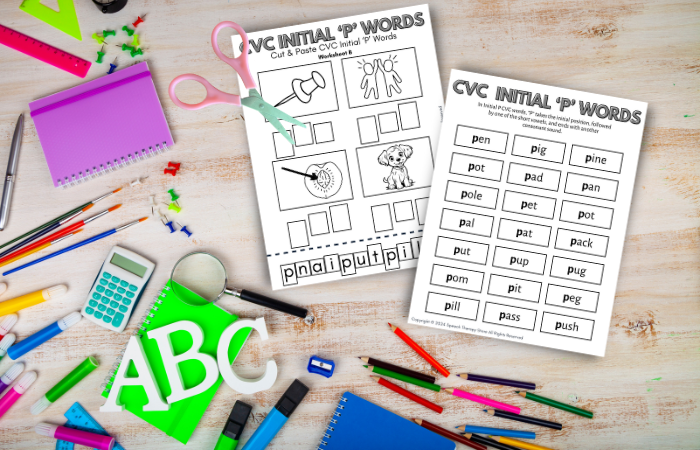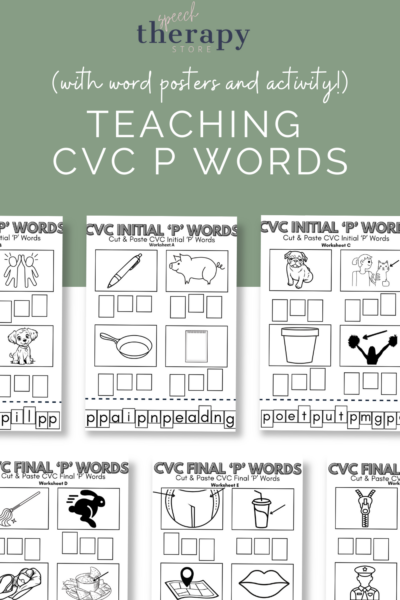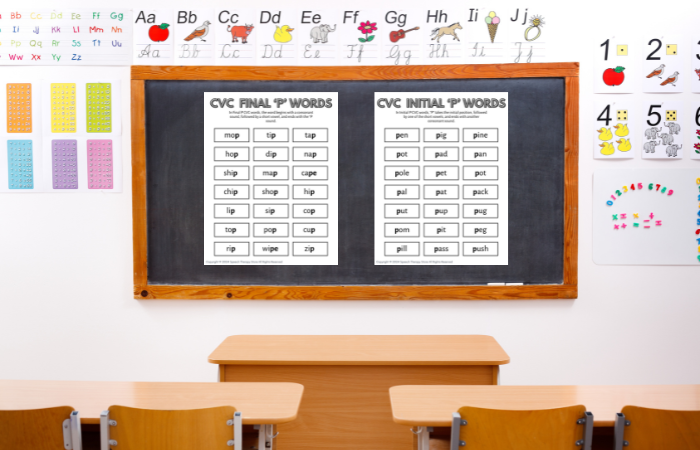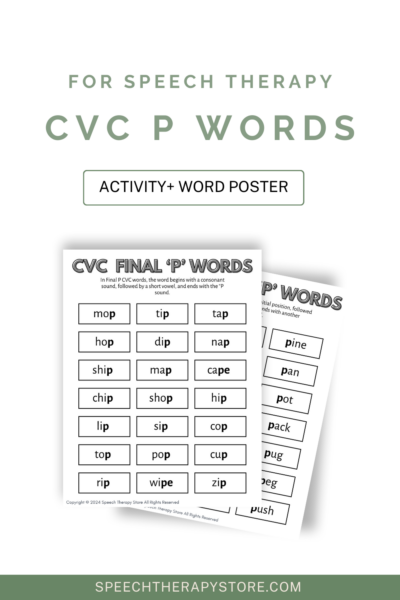CVC P Words: Mastering Simple Phonics for Early Readers
CVC words, or consonant-vowel-consonant words, such as cvc p words are fundamental building blocks in early literacy and language education.
They consist of a short vowel sound sandwiched between two consonants, making them an ideal starting point for children beginning to read and spell.
These simple structures not only reinforce the basic phonetic principles but also provide a clear and manageable way for young learners to practice blending sounds together to form a target word.

CVC P Words in Speech Therapy
In speech therapy, when focusing on CVC words that use ‘P’ as the initial or final consonant, we offer students a targeted approach to mastering a specific set of vocabulary.
Words like ‘pack,’ ‘tap,’ ‘pipe,’ ‘chip’ and ‘pup’ allow learners to hear and understand the short vowel sounds in different contexts, which contributes to their phonemic awareness.
In this blog, we will cover what a CVC word is, effective instruction for CVC P word as well as resource types for teaching CVC words.
In addition, we have created an Initial and Final CVC ‘P’ word poster as well as a free cut and paste game to teach CVC P Words for you to add to your lesson plans.
Key Takeaways
- CVC words aid in developing early reading and spelling skills.
- ‘P’ CVC words specifically help learners distinguish short vowel sounds.
- Teaching methods should engage students with interactive reading exercises.
Understanding CVC Words
CVC words are essential for early reading and building on letter sounds. They combine simple phonemic awareness with initial sound recognition.
As speech-language pathologists, when teaching CVC ‘P’ words, we should focus on the structure, the role of short vowels and specifically how the letter “P” fits into the word.

Phonemic Awareness
First, to teach CVC words, we can build on a students understanding of Phonemic Awareness.
- Phonemic Awareness is the ability to hear, identify and manipulate individual sounds – phonemes- in spoken word.
We can start off by using engaging activities like flash cards, boom cards or a free printable phonics resources from tpt sellers to reinforce the understanding of these sounds.
When teaching a P CVC sound, an effective strategy is to use labels or relevant words and pictures to enhance memory recall and identification of the “P” initial sound.
Structure of CVC Words
Consonant-vowel-consonant (CVC) words have a straightforward structure: the initial consonant, followed by a short vowel, and ending with a final consonant.
Here’s a table delineating the typical structure of CVC words:
| Position | Content | Example |
| 1st (Initial) | Consonant (C) | p |
| 2nd (Middle) | Short Vowel (V) | a |
| 3rd (Final) | Consonant (C) | t |
In P CVC words, “P” takes the initial position, followed by one of the short vowels, and ending with another consonant to form a word like “pat.”
CVC words with the letter ‘P’ establish foundational phonetics for early readers by allowing them to understand simple yet critical sound structures.
Initial Sounds with Letter ‘P’
When we introduce young learners to the letter ‘P’, we focus on its position as the initial sound in CVC words. The letter ‘P’ provides a distinct burst of air that makes it a clear and recognizable phoneme.
Here are examples of initial letter ‘P’ CVC words:
- P-a-n
- P-i-ck
- P-e-t
- P-o-p
The starting ‘P’ sound is essential, as it sets the tone for the entire word. By emphasizing words that begin with ‘P’, we make use of sounds that feel familiar and engaging for learners.
Final Sounds with Letter P
It is also important to focus on ‘P’ in the final position of CVC words.
Here are some examples of P in the final position
- H-o-p
- N-a-p
- C-u-p
- S-i-p
Below you will find our compiled word list of Initial and Final P CVC Words to practice with your students!
Also, don’t forget to download our freebie at the end of this post to grab a CVC Word Poster, as well as a fun cut and paste game!
| INITIAL P | FINAL P |
| pad | mop |
| pan | tip |
| pen | tap |
| peg | hop |
| pet | zip |
| pig | dip |
| pot | nap |
| pug | mop |
| pat | map |
| pin | cap |
| pop | cup |
| pot | sap |
| put | pup |
| pup | hip |
| paw | lip |
| pom | sip |
| pit | cop |
| peg | top |
| pip | pop |
| pat | nip |
| pal | rip |
SEE ALSO: 432+ Free Measurable IEP Goals
The Role of Short Vowels in CVC Words
Short vowels are essential to CVC words; they occupy the central position and greatly determine the pronunciation of the entire word.
For instance, the difference between “pat,” “pet,” and “pit” lies in the short vowels ‘a,’ ‘e,’ and ‘i’ respectively.
We can introduce these short vowel sounds through various mediums like phonics posters, ensuring that learners can recognize and produce these pivotal sounds accurately. This lays the foundation for their ability to decode and construct countless consonant-vowel-consonant words.

Teaching CVC Words
When teaching CVC words, it’s essential to use strategies that enhance phonemic awareness, provide a variety of instructional materials, and incorporate fun, engaging activities. We want to offer students foundational skills so that reading is enjoyable!
Teaching the ‘P’ CVC Sound
To teach the ‘P’ CVC sound effectively, concentrate on blending the three individual sounds smoothly. Each of these words follows a consonant-vowel-consonant pattern, allowing for straightforward and predictable pronunciation. We often incorporate silly words to make the learning process entertaining, which encourages the repetition needed to master the sounds.
We can also compare the ‘P’ sound to other continuous sounds like those made by the letters S, to highlight the difference between explosive and continuous phonemes. By associating the ‘P’ CVC sound with fun and relatable activities, we help students internalize the concept through playful interaction.
Here’s a brief activity outline we might use:
- Listen and Repeat: Hear the word and repeat it, focusing on the initial ‘P’ sound.
- Segment and Blend: Break the word down (e.g., /p/ /a/ /n/) and blend it back together.
- Silly Sentence Creation: Use a CVC word in a funny sentence, like “The pig in a wig did a jig.”
These strategies help us introduce and reinforce the CVC ‘P’ sound in an engaging and effective manner.
Effective Strategies
We begin by modeling how to sound out CVC words using teacher models and stress the importance of successive blending, ensuring our students can hear all the sounds and blend them together.
We can also consistently practice phonemic awareness through listening games and repetition exercises. It’s valuable to collaborate with speech-language pathologists when available, to integrate techniques that support correct pronunciation and sound recognition.
Instructional Materials
We utilize a range of free printable phonics resources to support learning in a tangible way.
For example, a P CVC poster can serve as a visual reminder of common CVC words starting with the letter P.
We also recommend CVC word fluency decks and boom cards. These resources encourage independent practice and help students reinforce their skills at their own pace.
Engaging Activities
Some engaging activities might be playing CVC bingo or participating in a CVC match game, turning learning into a fun experience. Or using technology by using interactive whiteboards for group sorts or interactive games that captivate our students’ interest. Additionally, CVC word fluency decks can be gamified to create a competitive yet educational environment that stimulates engagement and learning.
By incorporating these strategies, materials, and activities, we create a comprehensive learning experience that helps students master CVC words efficiently and enjoyably.
SEE ALSO: 430+ Multi-Syllabic Word Lists Activity Bundle

Educational Resources
In this section, we offer a selection of educational resources suited for teaching and reinforcing CVC (Consonant-Vowel-Consonant) P words.
These resources are tailored to support both printable and digital preferences so that both educators, parents and educators have access to these resources.
Here at Speech Therapy Store, we want to make your planning easier, so we also have created a Free CVC P Words poster and activity for you to use! Simply scroll to the bottom of this post for our CVC P Words Free Printables!
Printable Resources and Games
Flash Cards: To practice the letter P, use comprehensive flashcards! Feel free to cut our CVC P Words poster to create flashcards. We also recommend using flashcards that are clear and engaging for your students. A great way to do this is to have students color or trace a CVC word fluency deck. This will aid in understanding letter sounds and comprehension as well.
Here are some other great resources and games to practice consonant-vowel-consonant words.
- Phonics Posters Tags: Alongside flash cards, provide phonics posters tags that can be printed and displayed in classrooms or study areas. These serve as constant learning aids for children. Feel free to download and print our P CVC Poster below!
- CVC Match Match Game: A printable game can be used to reinforce the recognition of CVC P words through a fun, interactive matching activity. It’s great for individual or small group play. If you are looking for a good match match game, Articulation Basket Game for Bilabials initial P, B, M using CV, CVCV and CVC by The Speech Coop is an engaging matching articulation CVC game!
- CVC Bingo: CVC Bingo is another engaging printable game. It’s perfect for classroom settings or remote play, encouraging collaboration and social interaction among learners. Articulation Games CVC WORDS Make & Take BINGO, Speech Therapy Distance Learning by The Itinerant Clinician is a great bingo game to practice your CVC words with!
- Word Lists: We’ve curated specific word lists that focus on CVC P words. Teachers and parents can use these lists to create their own material or to guide their lessons. Check out our word list below!
Digital Tools and Apps
Interactive Digital Apps:
- CVC Words Interactive Game: An interactive digital tool that allows children to practice CVC P words in various contexts, enhancing their understanding and recall. We recommend using boom cards from your favorite TPT sellers, interactive whiteboards or a powerpoint slide to engage your students with digital resource types. If you are looking for a highly rated interactive game, FREE Boom Cards: Spring Speech Articulation Game (CVC SAMPLE) by Ausome speech is a spring themed CVC articulation game that students love!
SEE ALSO: The Best Handout for Phonological Processing

Practical Applications
In this section, we will focus on how CVC words can be integrated into learning environments like classrooms and homes for effective literacy development. By employing a combination of digital tools and hands-on activities, we can enhance the mastery of basic phonics skills necessary for reading.
Classroom Implementation
When we introduce CVC words in the classroom, it’s essential to use interactive whiteboards to display them. We can present the words with teacher models, allowing students to see clear examples. Our strategy may include a group sort activity, where students work together to categorize words, moving objects that represent different CVC words onto the correct section of the whiteboard.
For independent work, we encourage using flash cards. We can create a variety of simple words which students can practice reading and sorting individually. This not only reinforces their understanding of the word structure but also enables them to work at their own pace.
Home Practice and Support
To ensure consistent practice at home, we can provide parents with guidelines on how to use CVC flashcards effectively. We can also suggest activities where children move objects corresponding to flashcard words, linking physical action with their learning.
We also recommend establishing an email address where parents can reach out for additional resources or support. By maintaining open communication, we ensure that the practice of CVC words is both effective and aligned with our classroom methods.

Assessment and Progress Tracking
We recognize the importance of regular assessment and progress tracking when it comes to CVC (Consonant-Vowel-Consonant) words mastery. By employing strategic evaluation methods and interactive tools, we can gauge our students’ understanding and growth.
Conducting A Running Record
Conducting a running record is essential for assessing how well students are learning CVC words. When we administer a running record, we typically follow these steps:
- Select a passage: Choose a text that contains a balanced mix of CVC words.
- Ask the student to read aloud: While the student reads, we note the errors and self-corrections they make using common token symbols like check marks and dots.
- Analyze the record: Then review the recording to determine the types of errors and the student’s error rate, accuracy rate, and self-correction rate.
Our goal is to identify if there are specific CVC words or sound patterns that cause consistent issues, allowing us to tailor our teaching approach accordingly.
Monitoring Student Engagement
Monitor student engagement through several approaches:
- Interactive Games: We leverage interactive games, such as Boom Cards, to measure real-time student responses. These games provide instant feedback and often include common CVC words, which help us to observe how students interact with different words in a fun setting.
- Independent Work Tracking: Observing students during independent work times, such as when they’re engaged in fun activities like matching games or phonics puzzles, helps us understand their proficiency with CVC words.
- Student Journals: Incorporating journals where students write down CVC words and sentences enhances our ability to track their progression over time.
When students appear more actively involved in these activities, it typically reflects a stronger grasp of CVC words and phonetic concepts.

<< Fill out the form below to grab your free CVC P Words Poster and Cut and Paste Activity! >>
Frequently Asked Questions
In this section, we address some of the most common inquiries surrounding CVC words beginning with the initial sound /p/. Our aim is to provide clear, concise answers to enhance understanding and application of these phonics elements in educational settings.
What does CVC stand for in educational resources involving phonics?
CVC refers to the consonant-vowel-consonant pattern found in words. This pattern is a fundamental structure in early phonics learning, where children decode and encode simple words to build reading fluency.
How can initial /p/ CVC words be used to improve early reading skills?
Initial /p/ CVC words, such as ‘pat’ or ‘pen’, are excellent for teaching students the relationship between letters and sounds. Using these words, we can help learners recognize patterns, which facilitates the development of decoding skills crucial for reading.
What are some common three-letter CVC words that end with the letter ‘p’?
Common CVC words ending with ‘p’ include ‘cap’, ‘tap’, ‘lip’, ‘mop’, and ‘map’. These words are often among the first set of words that children learn to read due to their simple and consistent phonetic structure.
Can you provide five examples of CVC words that start with ‘p’?
Certainly. Five examples of CVC words that start with ‘p’ are ‘pat’, ‘pet’, ‘pig’, ‘pot’, and ‘pup’. These words help young readers grasp the sound that the letter ‘p’ makes at the beginning of words.
Which CVC words are typically taught first to beginners in reading?
For beginners in reading, CVC words such as ‘cat’, ‘dog’, ‘pen’, ‘top’, and ‘mud’ are often taught first. These words incorporate basic phonemes and simple patterns, providing a foundation for further phonics instruction.
How are CVC words useful in teaching basic writing and spelling?
CVC words aid in teaching writing and spelling by introducing straightforward patterns for learners to encode. These words allow us to demonstrate basic phonetic rules and give learners opportunities to practice spelling through simple, memorable words.

Want Even More Lesson Plans for Speech Therapy?
- Free SLP Planner [Updated Yearly]
- 917+ Best Free Boom Cards for Speech Therapy
- 31 Best Wordless Videos to Teach Problem Solving
- 133+ Categories List for Speech Therapy
- The Best Handout for Phonological Processing Disorder Therapy
Want the Best of the Bests?
Be sure to check out our most popular posts below!
- 21 Best Reinforcement Games for Speech Therapy / Teletherapy
- Best IEP Resources
- 71+ Free Social Problem-Solving Scenarios
- 430+ Free Multisyllabic Words List Activity Bundle
- 432+ Free Measurable IEP Goals and Objectives Bank
- 279+ Free Speech Therapy Digital Materials
- 179+ Free Speech Therapy Wh-Questions Printable
